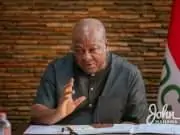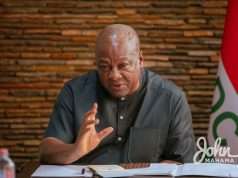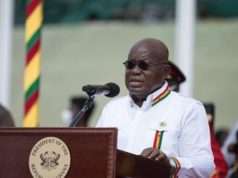President Nana Addo Dankwa Akufo-Addo has inaugurated the renovated Kwame Nkrumah Memorial Park, in Accra, to honour, promote and preserve the legacy of one of the greatest Pan-Africanists of all time.
Built in 1991 by the Jerry Rawlings-led Provisional National Defence Council (PNDC) government, the park, which sits at the Old Polo Grounds and covers an area of 5.3 acres, is where Ghana’s first President, Dr Kwame Nkrumah, flanked by his comrades in the Convention People’s Party (CPP) — Kojo Botsio, Komla Agbeli Gbedemah, Archie Casely- Hayford and Krobo Edusei — declared Ghana’s independence on March 6, 1957 before a huge ecstatic crowd.
It is the final resting place of Dr. Nkrumah and his wife, Fathia Nkrumah, and hosts rare artifacts relating to Ghana’s independence.
The remains of the ex-President, which were originally interred in his home town, Nkroful in the Western Region, were moved to the mausoleum that was constructed at the park. The Park was opened to the public in 1992.

Since its establishment in 1992, visitors from all over the world numbering up to about 98,000 each year, come and pay homage to Ghana’s first President, learn about his life, and legacies.
The Park is one of the 10 most visited sites in Ghana. After 25 years of existence of the Kwame Nkrumah Memorial Park, the facility had not seen any meaningful facelift. Indeed, at a point the fountains (which are major attractions) were not functioning well or regularly thus affecting visitations.
Moreover, the roof of the museum leaked each time it rained making it difficult to conduct visitors around. The situation was not different at the VIP lounge where most VIP guest of the State signed the visitors’ books after their tour.
Additionally, the main corridor to the washrooms and some parts of the washrooms were in a deplorable state.

In 2017, when President Akufo Addo took over as President of the Republic of Ghana, and recognize the important role of tourism in the development of the country, he declared Tourism as social advancement, with the potential to give a big boost to the economy.
In 2018, President Akufo Addo secured a $40 million loan facility from the World Bank through the Ministry of Tourism, Arts and Culture to; strengthen and enable the tourism environment; to address constraints most likely to have transformative impact on the sector; develop tourism sites and destinations; and finance the costs of tourism enterprises and business development services and training.
On May 27, this year, the Ministry of Tourism, Arts and Culture closed the park until further notice for major renovation works.
On July 19, 2022, the Minister of Tourism, Arts and Culture, Dr. Ibrahim Mohammed Awal, cut sod for the commencement of the rehabilitation and redevelopment of the Kwame Nkrumah Memorial Park and Mausoleum.

The reconstruction maintains the historical value of the Park, increase its visitor capacity and improve service delivery to visitors.
The mah, a 10.8 feet bronze statue, and an imposing mausoleum where his mortal remains and that of his wife, Fathia, are interred.
Other facilities include statues of horn blowers with a fountain surrounded by trees planted by some distinguished personalities, a library, conference and reception centres, an infirmary and a gift shop.
New introductions to the Park include an audio-visually synchronised fountain, mini-amphitheatre, as well as picnic area for the youth and visitors.
President Nana Akufo-Addo described the project as monumental– a project expected to boost Ghana’s international tourist arrivals significantly.
“We have a unique opportunity to transform our tourism sector,” he noted, stressing that the country was endowed with many heritage sites which could be developed and upgraded for revenue generation.

The Park, until its renovation, attracted some 90, 000 visitors annually, making it one of the top ten most visited tourist attraction sites in the country and West African sub-Region in general.
Ghana has made a projection of 1.2 million tourist arrivals by the end of 2023, and the Park is expected to add up significantly to achieving this target.
President Nana Akufo-Addo hinted that his Administration’s agenda was to make the country the hub of heritage tourism in the sub-Region.
Consequently, the existing forts and castles, as well as other monumental tourist attraction sites are being rehabilitated.
The Government has stepped up efforts to build new roads, renovate dilapidated ones, and construct airports to open up the country – making tourist attraction sites more accessible to visitors, the President noted.
On domestic tourism, he stressed the need for the Ministry of Tourism, Arts and Culture to work with the Metropolitan, Municipal and District Assemblies to encourage the citizenry to visit the country’s iconic tourist attraction sites.
The President lauded the World Bank for its assistance in renovating the Park and continued support to develop Ghana’s tourism sector.
The Government, he said, was committed to injecting the requisite resources to build the capacity of stakeholders in the tourism industry for effective service delivery.
Mr Pierre La Porte, the World Bank Country Director, paid a glowing tribute to the late Osagyefo Dr. Kwame Nkrumah, Ghana’s first President and Pan-Africanist extraordinaire, for his visionary leadership.
“This is a day that all Africans should be proud of,” he stated.
Mr. Ken Ofori-Atta, Minister of Finance, said the Government’s investment in the tourism industry aimed at creating jobs and wealth for the sustainable growth of the economy.
Dr. Ibrahim Mohammed Awal, Minister of Tourism, Arts and Culture, pointed out that with the repositioning and enhancements of the tourism, arts and cultural infrastructure, it was expected that the sector would become the number one contributor to Ghana’s Gross Domestic Product (GDP) by 2025.








































